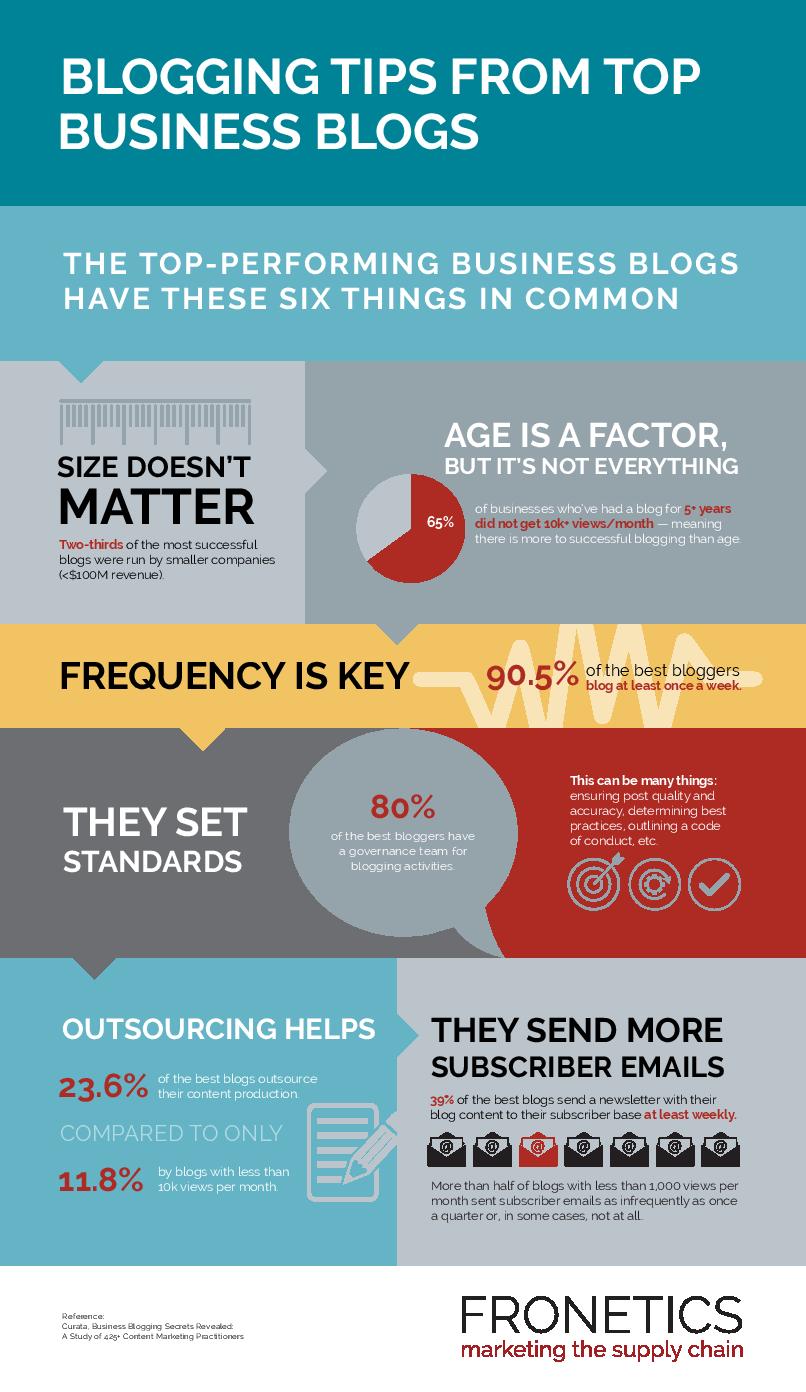![The Role of Content in the Logistics & Supply Chain Industries [Infographic]](https://www.fronetics.com/wp-content/uploads/2024/10/role-of-content.jpg)
by Fronetics | Feb 28, 2017 | Blog, Content Marketing, Logistics, Marketing, Supply Chain
Nearly 80% of logistics and supply chain companies consider content an effective tool for their businesses.
We often use this space to talk to the logistics and supply chain industries about content marketing. Some companies are surprised to learn that this modern marketing method can be so effective for their business. The truth is, content is one of the most useful tools for not only building brand awareness, but also generating leads and earning new customers.
I can tell you this until I’m blue in the face. But, really, what’s most convincing is seeing how other businesses in the industry approach content and how it’s paying off for them.
So we at Fronetics polled supply chain and logistics marketers to determine how their companies are using content. We wanted to find out whether it’s working, as well as their challenges; how they approach outsourcing, distribution, and curation; and more. The below infographic illustrates a few of the key findings from our survey.

(Made with Canva)
To get a complete picture of the role of content in the logistics and supply chain industries, download our report:

Related posts:

by Fronetics | Feb 23, 2017 | Blog, Marketing, Social Media, Supply Chain
Here’s what supply chain and logistics marketers need to know about recent social media news as of February 2017.
Staying on top of what’s happening in the ever-changing social media world is crucial, but can be a challenge. To keep you informed of some key developments, here’s our February 2017 edition of social media news for the supply chain.
Facebook shares Q4 and full-year 2016 earnings and community updates
Facebook announced that it now has nearly 1.9 billion users, including 1.2 billion people active every day. More than 65 million small businesses use Facebook as a marketing tool. Zuckerberg emphasized to investors that the company is committed to “putting video first across [its] family of apps and making it easier for people to capture and share video in new ways.”
LinkedIn adds option to disable comments on long-form articles
The site now allows publishers to manage comments on individual long-form articles “at any time.” LinkedIn plans to add the option to turn off comments on all posts “soon.” Publishers can now also report, flag, or hide abusive or offensive comments. Read more
Facebook algorithm updates geared to show more authentic and timely stories
Updates rolled out this month are intended to prioritize “more authentic and timely” content in the new feed. Posts and topics that are already getting “a lot of engagement” or “might be temporarily important to you” are getting a boost. Read more
Facebook extends lead ads to Instagram
Marketers can now run lead ads across both Facebook and Instagram placements. The company recommends that advertisers verify that the creative complies with Instagram’s design requirements for lead ads.
YouTube expands mobile live streaming and launches Super Chat
For creators with more than 10,000 subscribers, mobile live streaming is here, and other creators will have it “soon,” according to the company. YouTube also released Super Chat, “a new live stream monetization tool that lets any fan watching a live stream stand out from the crowd and get a creator’s attention by purchasing chat messages that are highlighted in bright colors and stay pinned to the top of the chat window for up to five hours.” Read more
Related posts:


by Fronetics | Feb 22, 2017 | Blog, Content Marketing, Marketing, Strategy
Follow these 4 steps to learn how to build a successful DIY content marketing strategy that will help grow your business.
Are you trying to create a content marketing strategy, but don’t know where to begin? Even the language around content marketing can seem foreign to newcomers. That’s why Fronetics created its guide, How to Grow Your Business with Content (download below) — to make creating a content marketing strategy possible for the DIYer in your company.
Setting your content marketing strategy is a crucial first step in trying to reach your target audience. Before you begin writing blogs and posting tweets, you need to set goals. A content marketing strategy outlines the methods by which you will target, reach, and engage your audience. Here are four steps, outlined in the guide, to creating a successful foundation to your content marketing strategy.
Steps to building a content marketing strategy
1. Identify your target audience and buyer persona(s)
Knowing who your ideal customer is allows you to create content that is informative, educational, and entertaining to that specific person. Trying to write compelling content for an unidentified audience is like taking a shot in the dark. The more detailed you can be with your buyer persona(s), the more specific and effective your content can become.
2. Define goals and objectives
Your content goals should be a direct reflection of your business goals. What do you want your content marketing efforts to accomplish for your company? The top marketing goals for content marketers in 2016 included converting contacts/leads to customers, growing website traffic, and increasing revenue derived from existing customers. Make sure you include short-term and long-term goals and that you frequently refer back to these goals to make sure your strategy is on track.
3. Developing and distributing content
Once you have identified your audience and defined your content goals, you can begin to educate yourself about the distribution platforms that will work best for your business. Let’s face it: Social media is not a one-size-fits-all solution. It’s imperative you know not only what to post but where to post it.
There are lots of great resources to help you optimize your content marketing presence. You can individualize your outreach so your blog posts are reaching one target audience, while your tweets are capturing another.
4. Put your knowledge to work
Once you have worked through the initial steps of planning a successful content marketing strategy, the real fun begins. It’s time to start pushing valuable, effective content out to consumers. If you’ve spent the time and effort up front to really thing through your strategy, you’ll reap the rewards in good time. Just remember that your strategy should be fluid, and you should be able to adjust your plans as you move forward and find what is working and what isn’t.
Pulling together a content marketing strategy for your B2B business can seem overwhelming. But having the right tools to support you can make all the difference. Download Fronetics’ easy-to-follow, step-by-step guide How to Grow Your Business with Content below to take the leap to a successful DIY content marketing strategy today.

Related posts:

by Fronetics | Feb 20, 2017 | Blog, Content Marketing, Marketing, Supply Chain
A recent survey of over 400 business blogs shows what the best bloggers have in common and what supply chain marketers can do to improve their blogs.
Maintaining a blog for your business can be somewhat of a guessing game. How often should you publish? Should you do all the writing in-house? Will anyone read our posts?
A recent survey of 428 marketers conducted by Curata sought to identify any patterns or trends among those with the most successful business blogs. Specifically, the authors grouped together those whose blogs had more than 10,000 views per month and compared them to those with less than 10,000 views per month.
The most successful blogs (those with over 10,000 views per month) have several things in common. The following infographic shows some highlights from the survey.

(Made with Canva)
Read the full report from Curata’s survey here to get more insight into the best business blogs. For more information and tips on blogging for your supply chain business, check out our related posts below.
Related posts:

by Fronetics | Feb 16, 2017 | Consumer Electronics, Content Marketing, Marketing, Social Media, Strategy, Supply Chain
Here are two examples of consumer electronics companies leveraging social media to reach their target audiences, build brand awareness, and drive sales.
More and more companies are allocating budget to create a social media presence. That’s because, despite early hesitation, supply chain businesses understand that social media is an important marketing tool in today’s marketplace. The consumer electronics industry is no different: Participating in social media has never been more necessary.
Nearly 60% of consumers have taken a blog or social media post into consideration while shopping in a store. You may think — sure, that probably happens for fashion labels. But in fact, consumer electronics is the top product category influenced by social media posts, followed by fashion, then household items.
So what does this mean for you? Those dollars that you’re driving into social networking posts, tweets, and videos are reaching customers and ultimately affecting their purchasing decisions. Well, I should say, only if you’re driving them in the correct places.
To effectively leverage social media in consumer electronics, you need to have a social media strategy that aligns with your business goals. You need to be using the right channels, distributing the right content, and posting at the right time.
Let’s take a look at two companies that are doing it right and why that is.
Consumer electronics companies leveraging social media effectively
1) GoPro
GoPro designs portable, waterproof cameras that users can strap on their helmets, handlebars, or surfboards to record their experiences. The brand’s target audience includes extreme-sports lovers and daredevils who like to watch and share their adventures.
As part of their social media strategy, GoPro encourages their customers to contribute their videos to its various social media channels. It’s a win-win for both the company and users: GoPro receives tons of content that is interesting and relevant to its users, and the users get to show off their skills (or tumbles). Today, the company has over 4.5 million YouTube subscribers and more than 1.3 billion views of their videos.
Lesson: Know your target audience. GoPro understands who it is trying to reach, what they like to do with social media, and where they are active. It gives users a place to share their accomplishments, and is able to grow brand awareness and brand loyalty at the same time.
2. Beats by Dre
Beats by Dre, owned by Apple and founded by Dr. Dre, is an audio brand that sells headphones, earphones, and speakers. The company is active on several social networking platforms, but its genius lies in how it uses those platforms in different ways to reach different consumers.
On Facebook, Beats by Dre finds the most success by sharing stories and experiences that appeal to music and sports enthusiasts. Content includes inspirational photos and videos of athletes and artists using the brand’s products.
On Twitter, the company has created a dedicated support account to quickly reach customers in need of service. This helps amplify the message that the company offers excellent customer service, and the team is able to quickly and broadly share users’ positive feedback.
Pinterest is an entirely different beast for Beats by Dre. The company found its users were most likely to pin high-quality, interesting images, so that’s exactly the kind of content the brand shares via Pinterest. It also curates “mood boards” around the release of new products. It helps build excitement and awareness surrounding a product launch — and it achieves the longer-term strategy of building brand awareness through its users’ social sharing.
Lesson: What works on one social media network might not work on another. By distributing different kinds of content on different channels, Beats by Dre has been able to maximize the impact of each social media channel and engage with the segment of consumers that operates there.
Today’s consumers are more educated than ever. By understanding how to leverage your social media channels to reach and best serve your target audience, you can make your tweets, posts and videos a success.
Related posts:
![The Role of Content in the Logistics & Supply Chain Industries [Infographic]](https://www.fronetics.com/wp-content/uploads/2024/10/role-of-content.jpg)









